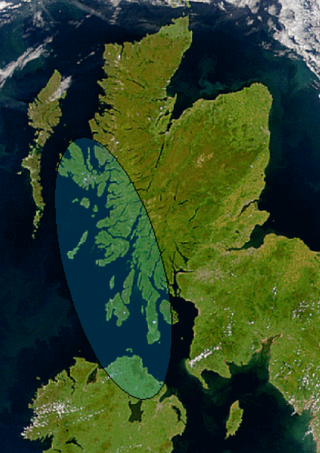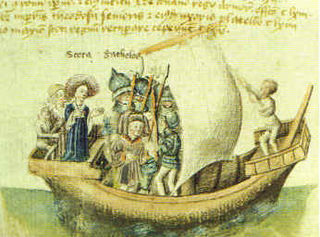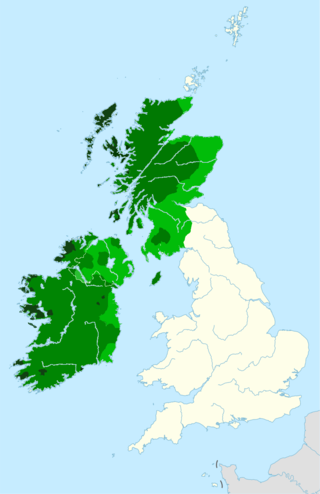
Causantín mac Áeda was an early King of Scotland, known then by the Gaelic name Alba. The Kingdom of Alba, a name which first appears in Constantine's lifetime, was situated in modern-day Northern Scotland.
The Goidelic or Gaelic languages form one of the two groups of Insular Celtic languages, the other being the Brittonic languages.

Scottish Gaelic, also known as Scots Gaelic or simply Gaelic, is a Goidelic language native to the Gaels of Scotland. As a Goidelic language, Scottish Gaelic, as well as both Irish and Manx, developed out of Old Irish. It became a distinct spoken language sometime in the 13th century in the Middle Irish period, although a common literary language was shared by the Gaels of both Ireland and Scotland until well into the 17th century. Most of modern Scotland was once Gaelic-speaking, as evidenced especially by Gaelic-language place names.

Dál Riata or Dál Riada was a Gaelic kingdom that encompassed the western seaboard of Scotland and north-eastern Ireland, on each side of the North Channel. At its height in the 6th and 7th centuries, it covered what is now Argyll in Scotland and part of County Antrim in Northern Ireland. After a period of expansion, Dál Riata eventually became associated with the Gaelic Kingdom of Alba.

Scoti or Scotti is a Latin name for the Gaels, first attested in the late 3rd century. It originally referred to all Gaels, first those in Ireland and then those who had settled in Great Britain as well, but it later came to refer only to Gaels in northern Britain. The kingdom to which their culture spread became known as Scotia or Scotland, and eventually all its inhabitants came to be known as Scots.

Lir or Ler is a sea god in Irish mythology. His name suggests that he is a personification of the sea, rather than a distinct deity. He is named Allód in early genealogies, and corresponds to the Llŷr of Welsh mythology. Lir is chiefly an ancestor figure, and is the father of the god Manannán mac Lir, who appears frequently in medieval Irish literature. Lir appears as the eponymous king in the tale The Children of Lir.

The Milesians or sons of Míl are the final race to settle in Ireland, according to In the Lebor Gabála Érenn, a medieval Irish Christian pseudo-history. The Milesians represent the Irish people. The Milesians are Gaels who sail to Ireland from Iberia (Hispania) after spending hundreds of years travelling the earth. When they land in Ireland they contend with the Tuatha Dé Danann, who represent the Irish pantheon of gods. The two groups agree to divide Ireland between them: the Milesians take the world above, while the Tuath Dé take the world below.

In medieval Irish and Scottish legend, Scota is the daughter of an Egyptian pharaoh and ancestor of the Gaels. She is said to be the origin of their Latin name Scoti, but historians say she was purely mythological and was created to explain the name and to fit the Gaels into a historical narrative.

Caledonia was the Latin name used by the Roman Empire to refer to the part of Scotland that lies north of the River Forth, which includes most of the land area of Scotland. Today, it is used as a romantic or poetic name for all of Scotland. During the Roman Empire's occupation of Scotland, the area they called Caledonia was physically separated from the rest of the island by the Antonine Wall. The Romans several times invaded and occupied it, but unlike the rest of the island, it remained outside the administration of Roman Britain.

The Kingdom of Alba was the Kingdom of Scotland between the deaths of Donald II in 900 and of Alexander III in 1286. The latter's death led indirectly to an invasion of Scotland by Edward I of England in 1296 and the First War of Scottish Independence.

The Norse–Gaels were a people of mixed Gaelic and Norse ancestry and culture. They emerged in the Viking Age, when Vikings who settled in Ireland and in Scotland became Gaelicised and intermarried with Gaels. The Norse–Gaels dominated much of the Irish Sea and Scottish Sea regions from the 9th to 12th centuries. They founded the Kingdom of the Isles, the Kingdom of Dublin, the Lordship of Galloway, and briefly ruled the Kingdom of York. The most powerful Norse–Gaelic dynasty were the Uí Ímair or House of Ivar.

The origins of the Kingdom of Alba pertain to the origins of the Kingdom of Alba, or the Gaelic Kingdom of Scotland, either as a mythological event or a historical process, during the Early Middle Ages.

The High Middle Ages of Scotland encompass Scotland in the era between the death of Domnall II in 900 AD and the death of King Alexander III in 1286, which was an indirect cause of the Wars of Scottish Independence.

In medieval Irish and Scottish legend, Goídel Glas is the creator of the Goidelic languages and eponymous ancestor of the Gaels. The tradition can be traced to the 11th-century Lebor Gabála Érenn. A Scottish variant is recorded by John of Fordun.

Scotland is a country that occupies the northern third of the island of Great Britain and forms part of the United Kingdom. The name of Scotland is derived from the Latin Scoti, the term applied to Gaels. The origin of the word Scotia dates back to the 4th century and was first used by Roman writers to describe the northern Gaelic group of raiders that left present-day Ireland and landed in west coast Scotland.

The Kingdom of Munster was a kingdom of Gaelic Ireland which existed in the south-west of the island from at least the 1st century BC until 1118. According to traditional Irish history found in the Annals of the Four Masters, the kingdom originated as the territory of the Clanna Dedad, an Érainn tribe of Irish Gaels. Some of the early kings were prominent in the Red Branch Cycle such as Cú Roí and Conaire Mór. For a few centuries they were competitors for the High Kingship of Ireland, but ultimately lost out to the Connachta, descendants of Conn Cétchathach. The kingdom had different borders and internal divisions at different times during its history.

The Gaels are an ethnolinguistic group native to Ireland, Scotland and the Isle of Man. They are associated with the Gaelic languages: a branch of the Celtic languages comprising Irish, Manx and Scottish Gaelic.
Scottish Gaelic literature refers to literary works composed in the Scottish Gaelic language, which is, like Irish and Manx, a member of the Goidelic branch of Celtic languages. Gaelic literature was also composed in Gàidhealtachd communities throughout the global Scottish diaspora where the language has been and is still spoken.
Aonghas is a masculine given name in Scottish Gaelic. Derived from the Old Irish given name Oíngus, it is composed of Celtic elements meaning "one" and "choice". A variant spelling of the Scottish Gaelic name is Aonghus. The Irish form of the Scottish Gaelic names is Aengus. A pet form of the Scottish Gaelic name is Angaidh, which is represented in English as Angie.

Scottish Gaelic, is a Celtic language native to Scotland. A member of the Goidelic branch of the Celtic languages, Scottish Gaelic, like Modern Irish and Manx, developed out of Middle Irish. Most of modern Scotland was once Gaelic-speaking, as evidenced especially by Gaelic-language placenames.

















